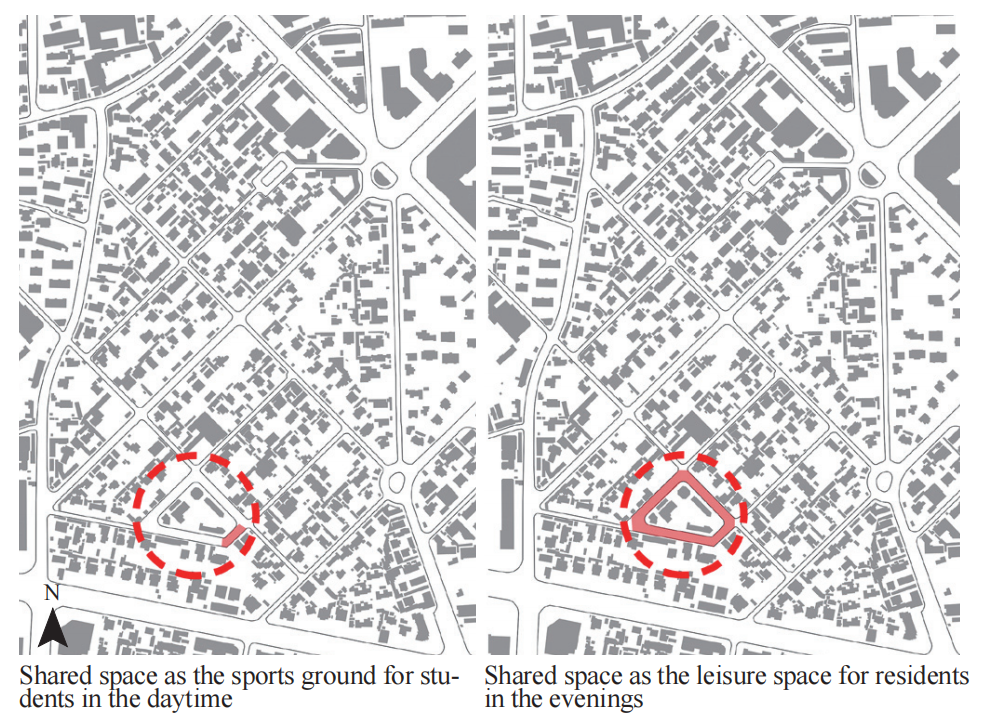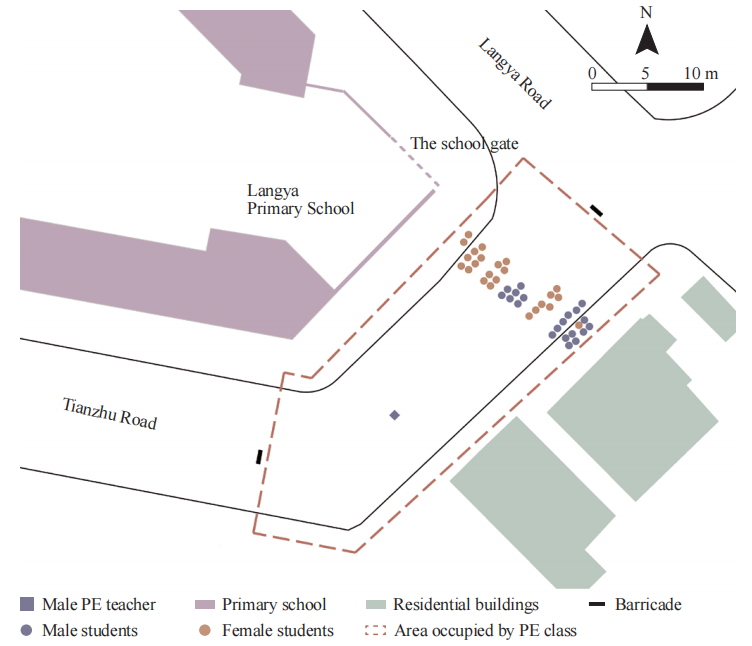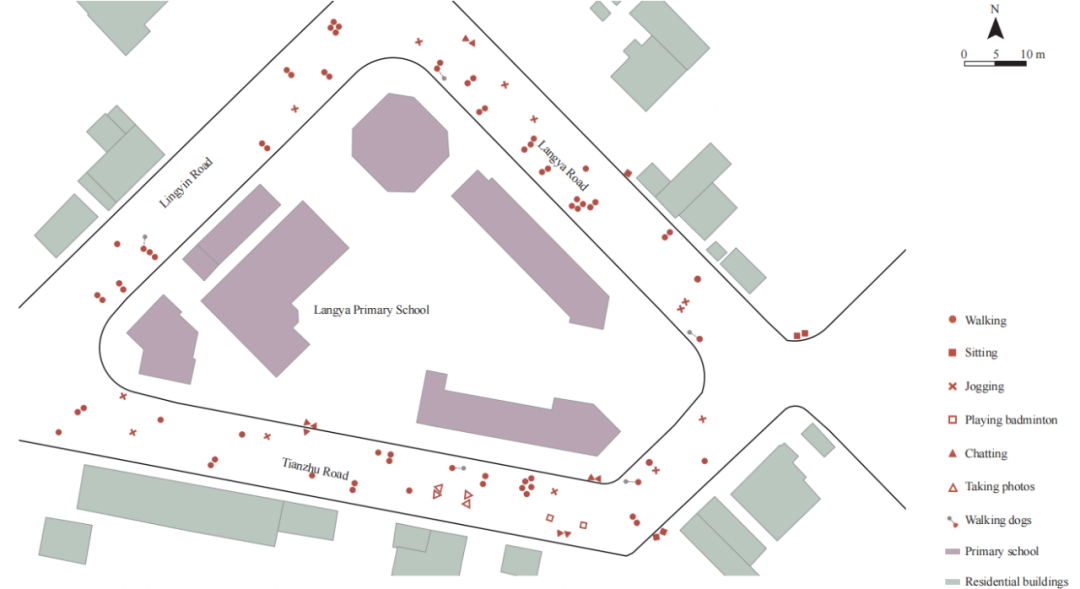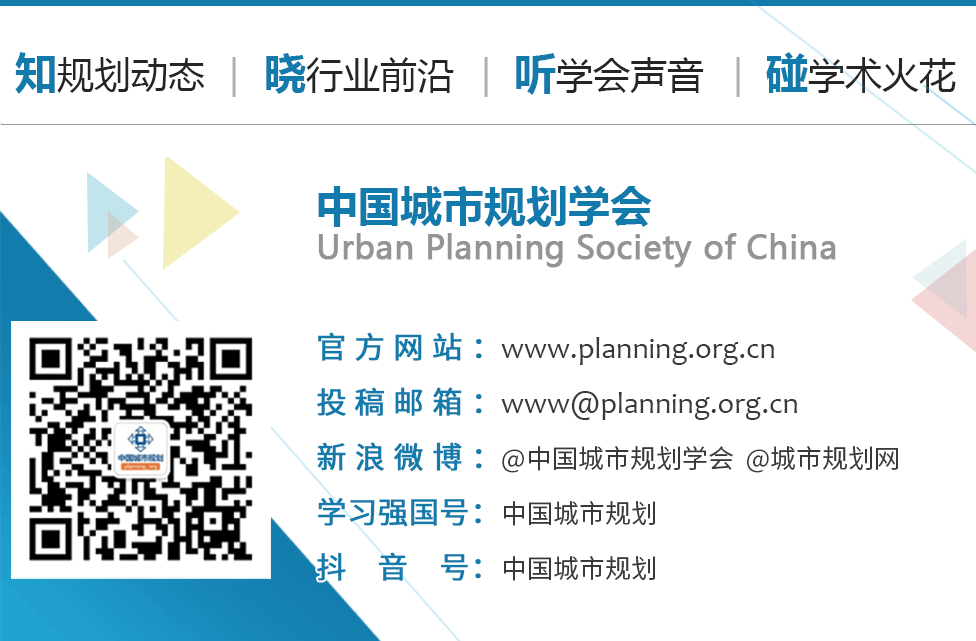导读
由中国城市规划学会主办的《China City Planning Review》(CCPR),中文刊名《城市规划(英文版)》,是EBSCO 收录期刊、CSCD 核心库收录期刊、CNKI 全文收录期刊、ProQuest 收录期刊。“中国城市规划”联手“ CCPR”为读者打造双语专栏,拓宽内容广度。
本文字数:3905字
阅读时间:12分钟

文章题目

空间共享与共享空间——来自南京的案例研究
Space Sharing and the Shared Space: A Case Study in Nanjing
作者

宋晟, 刘丹, 肖敏
Song Sheng, Liu Dan, Xiao Min
文章介绍

共享实践是21世纪的新兴现象。既有文献对共享实践的研究主要集中在共享经济、共享单车计划、食物共享和共享住房等,并从社会、文化、政治和组织方面进行了讨论,但是对空间共享的研究则相对缺乏。本研究希望从社区居民共享公共空间的视角来审视空间共享实践的社会-空间维度,并填补这一研究空白。本研究的目的是为了更好地理解空间共享实践的物理属性及其对人们日常生活的影响。为了实现这一目标,研究问题被定义为:空间共享实践的主要社会-空间特征是什么?
在《牛津词典》中,“共享”被定义为在不同个人之间分配金钱、材料或目标的行为或活动;与他人共同使用、占有、享受空间或资源;与他人共同拥有观点或品质。本研究中的“共享文化”是指当地居民以非营利目的,分享、管理和共同生产有形与无形资源的活动,以及不同利益相关者在此过程中发展出的社会网络,以更“可持续、灵活多样和社会参与”的方式服务于人们的需求和机会。
根据文献研究,“空间共享实践”包含三个相互联系的方面:共享空间资源的新方式、共享空间的生产以及在此实践过程中产生的社会-空间关系。为了进一步构建空间共享的一般性理论,提出了城市空间共享的三个主要尺度,即“城市公共空间共享”、“生活空间共享”和“社会空间共享”。日本、韩国、英国和中国的实践案例也表明,空间共享实践有助于增强社区参与,建立社区居民之间的信任,促进沟通。
为了厘清共享空间是怎样形成的以及共享空间怎样影响人的生活,本文采用定性案例研究的路径。南京颐和路社区被选作案例,原因有二。第一,其城市环境密度较高,人员活动丰富,为研究空间共享活动提供了丰富的材料。第二,该社区人口同质性高,相似的背景和居民的共同需求使“分享”更有可能实现。参与式观察和半结构式访谈是本研究的核心方法。18位受访者中,包括13名居民、4位游客和1位社区工作人员。
研究发现,居民们通过共享社区内琅琊路小学周围的公共街道,满足了日常需求。该空间共享实践包括一个时序使用和两个主要的使用模式。时序使用由七个时段组成。居民们根据时间顺序重新定义并重新利用了公共街道。街道的主要功能在正常使用(normal use)和临时使用(temporary use)之间转换。一种使用模式是,居民们和学校的学生们在白天共用一条特定的街道(天竺路),以满足学生们对运动场地的需求。另一种使用模式是,居民们在晚上共享学校周围的街道(天竺路、灵隐路和琅琊路),并利用这些公共空间进行体育锻炼、娱乐活动和社交互动。
在第一种使用模式中,学校作为行动者之一,表现出强烈的愿望,并利用时间、能力和资源去解决其运动空间不足的问题。因为大部分在校学生就是社区居民的孩子,所以居民们和学校有共同的需求和利益。不同的利益相关者,包括学校、社区居民和当地政府,花费时间和努力确定了用于共享的物理空间,并建立了共享规则。由于密集的城市结构,该社区的公共空间有限。在第二种使用模式中,居民们利用他们的技能和既有的资源创造了一个休闲空间来满足他们的需求,并提高生活宜居性。值得注意的是,大多数居民隶属于同一个单位,并且彼此熟悉,这提高了达成共享实践的可能性。研究结果表明,公共空间适当的物理条件是空间共享实践的前提。空间共享实践可以相应地增强社区意识和社会凝聚力。
然而,此共享实践中也存在一些弊端。第一,参与共享实践的人在社会群体方面表现出高度的同质性。大部分居民隶属于同一工作单位,有相似的教育背景、收入和需求。在访谈中,13位居民都表示,考虑到安全性和使用权,不愿意与陌生人共享该空间。某种程度上,该共享实践只发生于社区居民之中,没有惠及到更广大的城市使用者,与城市正义的多样性相抵触。
第二,在第一种使用模式中,出现了一定程度的公共空间私有化。当学校在天竺路的一段街道上设置障碍物,只允许该校学生使用时,虽然没有改变街道的所有权,但清晰划定的空间和通行控制排斥了其他使用者,这减少了空间的多样性、活力和公平性。
本研究对我国当前的城市设计与城市更新具有以下启示。第一,除了传统的空间布局、形式和功能外,“时间”应该作为城市设计和城市更新的一个重要因素。我们的案例表明,使用者可以通过自发性活动和“时间”这一工具,对空间进行改造和重塑。因此,在城市设计和城市更新中增加“时间”层次,可以有效地回应城市发展的多样性、不确定性和可持续性。第二,有必要在城市设计和城市更新中协调不同利益相关者的需求。在我们的案例中,我们看到了各种利益相关者和机构参与了空间共享的实践。每个利益相关者对空间的共同生产都有着重要的影响。一个成功的城市空间应该是多功能的、能满足多种目的,无论在物理性质上还是社会层面上都具有可达性,并且在长时间内吸引着人们。
本研究提出两条建议与措施,希望为不同的社会群体创造令人满意的空间使用机会。首先,应该鼓励和发展社区居民的自治。通过激励居民的个人主动性、创造力和技能,可以改善物理空间和社会服务。其次,相邻社区可以共享内部公共空间或社会服务。通过共享公共空间或社会服务,可以促进不同的人群在同一地点的社交和相互了解,减少偏见。共享实践在不同社区的广泛分布有助于将其扩大到城市层面,并可能消除社会隔离。
Sharing practices are emerging phenomena in the 21st century. The existing literature mainly focuses on sharing practices such as sharing economy, bike-sharing schemes, food sharing and co-housing regarding the social, cultural, political and organizational dimensions. However, the space of sharing has been less-examined in the literature. This paper expects to fill the gap by examining the socio-spatial dimensions of space-sharing practices through the lens of sharing public spaces by community residents. The aim of this study is to better understand the physical attributes of space-sharing and the influences on people’s everyday lives. To achieve this aim, the research question is framed as: what are the main socio-spatial features of space-sharing practices?
In Oxford Dictionary, “share” is defined as an act or activity that we distribute money, materials or aims between different individuals; we use, occupy, enjoy a space or resource jointly with others; we own a view or quality mutually with people. In this paper, “sharing culture” refers to activities that local people share, manage and co-produce both tangible and intangible resources for non-profit purposes, and the social networks developed between various stakeholders in the process to serve people’s needs and opportunities in a more “sustainable, resourceful and socially engaging” manner.
According to the literature, “space-sharing practice” has three linked aspects: new ways of sharing spatial resources, the production of shared spaces, and socio-spatial relations generated in the practice. To further construct a general theory of space-sharing, three principal scales of space-sharing in cities were proposed, including “the sharing of urban public spaces”, “the sharing of a living space” and “the sharing of a social space”. In practice, cases in Japan, Korea, the United Kingdom and China demonstrate that space-sharing helps enhance community engagement, build trust and promote communications among community residents.
To answer “how” shared spaces are formed and “how” shared spaces influence peoples’ lives, this research employs a qualitative case study approach. Yihe Road neighborhood located in Nanjing city in Eastern China was chosen as the case study site. The neighborhood was chosen for two main reasons. First, it is a dense urban area with various human activities, which provides rich materials to study space-sharing activities. Second, the neighborhood has a homogeneous population. The similar background and common needs of the residents make “sharing” more likely to achieve. This research adopted two core methods – participant observation and semi-structured interviews, which offered different perspectives on the socio-spatial dimension of space-sharing. Eighteen participants were recruited, including thirteen residents, four visitors and one community staff.
The most significant finding emerging from the analysis is that in order to fulfill their everyday needs, residents share public streets around one public facility – the Langya Primary School. This space-sharing practice includes a temporal sequence and two main use patterns. The temporal sequence consists of seven periods. The residents redefined and reused the public streets following an order. The main function of the streets shifts between normal use and temporary use. One use pattern is that residents and primary school students share one particular street during the daytime to meet the students’ needs for the sports ground. The other is that residents share streets around the school in the evenings and utilize the shared spaces for physical exercises, recreational activities and social interactions.
In terms of the first use pattern, the school showed a strong desire and searched for solutions using its time, capacity and resources to deal with the lack of sports fields. Furthermore, the residents and the school students had a common need and good because most students were offspring of the residents. Different stakeholders including the school, neighborhood residents and local government took time and efforts to find a physical space and establish the sharing rule. The neighborhood has limited public spaces due to the dense urban fabric. In terms of the second use pattern, residents used their skills and the existing resources to create a leisure space to meet their requirements. It is noted that most residents belong to the same work unit and are acquainted with each other, which improves the possibility of reaching an agreement on the sharing practice. The research findings reveal that the appropriate physical conditions of the public space are the prerequisites for space-sharing. In turn, space-sharing practices enhance the sense of community and social cohesion.
However, some drawbacks were identified as well. First, people engaged in the sharing practice showed high homogeneity in terms of the social group. Most residents were affiliated with the same work unit and had similar educational backgrounds, incomes and demands. When being asked whether they are willing to share the space with visitors or non-residents, all thirteen residents interviewed conveyed their reluctance to do so. The main reasons included the fear of uncertainty and insecurity that strangers may bring and the exclusive use of the resources. In a sense, the sharing practice in our case took place among a group of neighborhood members and may not scale up to a variety of citizens, which contradicts the diverse nature of urban justice.
Second, in the first use pattern of the sharing practice, a level of privatization of public spaces emerged. In our case, the streets were publicly owned and the owner was not changed in the space-sharing process. However, the clearly delineated space and access control make this urban space under surveillance and exclusion of other users, which diminishes the diversity, vitality and equity of spaces.
The policy and practice implications from this research relate primarily to the urban design and/or urban renewal within the Chinese context. First, “time” is suggested as an important factor in urban design and/or urban renewal besides the conventional spatial arrangements, forms and functions. Our case demonstrates that space users can transform and reshape the space after it has been designed and built by users’ activities and through the tool of time. Thus, adding the layer of “time” in urban design and/or urban renewal can effectively respond to the diversity, uncertainty and sustainability of urban development. Second, it is necessary to coordinate the needs of different stakeholders in urban design and/or urban renewal. In our case, we see various stakeholders and agencies involved in the space-sharing practice. Each stakeholder has an important impact on the co-production of space. A successful urban space is suggested to be a multi-purpose place that is commonly accessible both physically and socially, and further, it attracts people back again and again over a long period of time.
This research proposes two recommendations for creating convenient and satisfactory opportunities for space use in different social groups. First, self-governance by neighborhood residents should be encouraged and developed. By motivating residents’ individualinitiative, creativity and skills, the physical spaces and social services could be improved. Second, it is suggested that adjacent communities can share the internal public spaces or social services for mutual benefits. By sharing public spaces or social services, different people encounter in the same places, socialize with each other, understand each other, and decrease bias. The wide distribution of sharing practices in different neighborhoods helps to scale up the sharing practices to a city level and could eliminate social segregation.
关键词

空间共享;共享空间;社会空间特征;南京
space sharing; shared spaces; socio-spatial features; Nanjing
主要图表


Figure 1 The map of Yihelu Neighborhood
图1 颐和路社区地图

Figure 4 Two use patterns included in the space-sharing practice in Yihelu Neighbourhood
图4 颐和路空间共享实践中的两种使用模式
Table 1 Temporal use of the public space
表1 公共空间的时序使用


Figure 5 The behavior mapping of students attending the PE class
图5 学生上体育课时的行为图绘

Figure 7 The behavior mapping of residents sharing and transforming streets into a leisure space to meet their social needs
图7 行为图绘显示居民将街道转化为休闲空间以满足其社会需求
作者介绍

宋晟,博士,讲师,长沙理工大学建筑学院,长沙。
电子邮箱:song_sheng@163.com
Song Sheng, PhD, Lecturer, College of Architecture, Changsha University of Science & Technology, Changsha, P. R. China. Email: song_sheng@163.com
刘丹,博士,副教授,长沙理工大学建筑学院,长沙。
电子邮箱:laudan2004@hotmail.com
Liu Dan, PhD, Associate Professor, College of Architecture, Changsha University of Science & Technology, Changsha, P. R. China. Email: laudan2004@hotmail.com
肖敏,博士,副教授,长沙理工大学建筑学院,长沙。
电子邮箱:xiaominhn@163.com
Xiao Min, PhD, Associate Professor, College of Architecture, Changsha University of Science & Technology, Changsha, P. R. China. Email: xiaominhn@163.com
全文链接

http://www.ccprjournal.com.cn/news/10226.htm
欢迎您通过以下方式查询购买:
To purchase the new issue of CCPR, please contact us via:
Tel:010-82819550, Email:ccpr@planning.org.cn.
您也可以登陆网站进行文章浏览:
Or you can also read the papers via:
www.ccprjournal.com.cn
扫码关注
CCPR城市规划(英文版)
↓↓↓

China City Planning Review (《城市规划(英文版)》)创刊于1985年,为中国城市规划学会会刊。国内城市规划领域唯一全英文期刊,致力于向国外读者介绍国内本领域最新学术研究成果。
本文来源:CCPR城市规划英文版
【免责声明】本公众号发布的内容仅供学习交流使用,不以任何形式进行牟利。内容版权归原作者所有。如有侵犯您的权益,请及时与我们联系,我们将于第一时间协商版权问题或删除内容。内容为作者个人观点,不代表本公众号立场和对其真实性负责。
你可能还想看这些
【CCPR专栏】Glossary | 常用英文规划术语⑧

点击图片阅读全文

【CCPR专栏】Glossary | 常用英文规划术语⑦

点击图片阅读全文

【CCPR专栏】文章推荐 | 城市环境对女性情绪健康影响及规划提升研究——基于神经科学实验的广州实证

点击图片阅读全文


原文始发于微信公众号(中国城市规划):【CCPR专栏】文章推荐 | 空间共享与共享空间——来自南京的案例研究
 规划问道
规划问道





